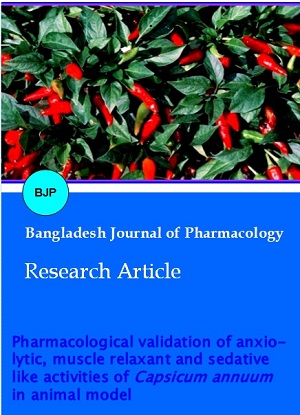Pharmacological validation of the anxiolytic, muscle relaxant and sedative like activities of Capsicum annuum in animal model
DOI:
https://doi.org/10.3329/bjp.v12i4.33182Keywords:
Anxiolytic, Capsicum annuum, Muscle relaxant, SedativeAbstract
The current study deals with anxiolytic, muscle relaxant and sedative like activities of Capsicum annuum in animal models. The crude extract was found safe in acute behavior and toxicity studies. However, the n-hexane fraction caused severe acute toxicity. Pretreatment of crude extract and n-hexane fraction elicited marked dose-dependent antianxiety-like effects in elevated plus-maze and dark and light models. The results showed significant (p< 0.05) antianxiety-like effects of crude extract while highly significant (p< 0.001) for n-hexane fraction. Similarly, an effect on muscle coordination was tested in traction model, where both crude extract and n-hexane fraction evoked marked dose-dependent activity. The effect of thiopental-induced sleep test of crude extract and n-hexane fraction was highly significant (p< 0.001). All together, the results revealed potent anxiolytic, muscle relaxant and sedative like activities of C. annuum in animal models and the pharmaco-logically active constituents are mostly non-polar in nature.
Video Clip of Methodology:
4 min 31 sec: Click to watch
Downloads
274
237 Read
58

Published
How to Cite
Issue
Section
License
Authors who publish with this journal agree to the following terms:
- Authors retain copyright and grant the journal right of first publication with the work simultaneously licensed under a Creative Commons Attribution License that allows others to share the work with an acknowledgement of the work's authorship and initial publication in this journal.
- Authors are able to enter into separate, additional contractual arrangements for the non-exclusive distribution of the journal's published version of the work (e.g., post it to an institutional repository or publish it in a book), with an acknowledgement of its initial publication in this journal.
- Authors are permitted and encouraged to post their work online (e.g., in institutional repositories or on their website) prior to and during the submission process, as it can lead to productive exchanges, as well as earlier and greater citation of published work (See The Effect of Open Access).
